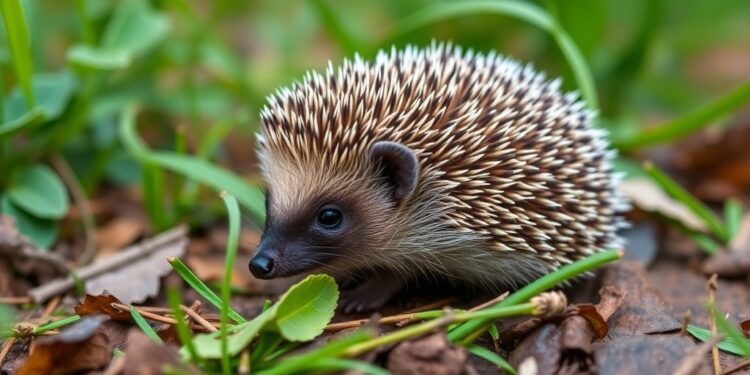Urban environments are often thought to be buzzing with life, yet they frequently mask hidden dangers lurking within the complex interactions of various ecosystems. A groundbreaking study from Lund University in Sweden sheds light on this pressing issue by revealing a disturbing array of environmental pollutants present in hedgehogs. The research uncovered concerning levels of lead, brominated flame retardants, pesticides, and polychlorinated biphenyls (PCBs), among other toxins, raising alarms about the implications for both wildlife and human health in urban areas.
Historically, studies have documented high levels of heavy metals in urban wildlife across Europe. However, the Lund team, led by ecotoxicologist Maria Hansson, was taken aback by the variety of pollutants they found during their examination of deceased hedgehogs. This prompted further investigation to determine the extent of contamination and its potential risks. The team aimed to create a more extensive profile of pollutants affecting urban hedgehogs, especially as these creatures roam substantial distances through parks and gardens while feeding on insects and other invertebrates, making them particularly vulnerable to such contaminants.
The researchers collected dead hedgehogs from various sources, including those reported by the public and those submitted for rehabilitation but that did not survive. Analyzing the livers of these hedgehogs provided the team with insight into both long-term exposure to heavy metals via spines and teeth and short-term exposure to a wide array of organic pollutants. The results were alarming, revealing elevated concentrations of environmental chemicals that are known to have detrimental effects on health.
Among the various pollutants discovered, lead levels were particularly high, accompanied by several organic contaminants such as phthalates which are commonly used as plasticizers in many consumer products. PCBs, despite being banned for manufacturing since the 1970s due to their severe health impacts, were also detected, highlighting persistent environmental health issues linked to historical pollutants. Added to the list were pesticides, brominated flame retardants, and polycyclic aromatic hydrocarbons (PAHs), forming a troubling cocktail of toxic substances present in urban habitats.
The findings of this research document the extent of environmental contamination in urban habitats without a restrictive lens, indicating that human activity contributes significantly to the introduction and maintenance of these harmful substances in ecosystems. With the rapid growth of urban populations and the simultaneous decline in natural habitats, understanding the implications of these pollutants cannot be overstated. Urban green spaces, while serving as vital biodiversity hotspots, are often rife with synthetic materials, chemical residues, and other pollutants that compromise the health of the species inhabiting them.
Maria Hansson emphasized the importance of this research, stating that analyzing hedgehogs serves as an effective environmental indicator for assessing ecosystem health in densely populated areas. The data elucidates the types and concentrations of pollutants that urban wildlife are grappling with and challenges the longstanding belief that these areas are safe havens for wildlife. The study advocates for expanded monitoring of soil and organisms in urban environments, which is crucial for formulating strategies to mitigate the impacts of pollution.
Despite hedgehogs being a red-listed species, the researchers raised ethical concerns regarding the use of animal carcasses in studies like this. Maria Hansson reiterated that while studying existing carcasses is preferable to causing harm to live animals, understanding the impacts of environmental contaminants on wildlife remains critical for both conservation efforts and public health initiatives.
While the research elucidates the presence of these harmful substances, the exact mechanisms through which they affect hedgehogs and other species remain largely unexplored. Much about how various species respond to environmental pollutants continues to be a mystery, complicating conservation efforts further. Given the mammalian similarities between hedgehogs and humans, the detection of endocrine disruptors and carcinogens within these urban creatures raises significant alarm bells about the potential health repercussions for urban populations exposed to the same pollutants.
The project’s revelations serve as an urgent call to action, highlighting that urban environments contain significant quantities of substances known to be harmful to both human health and ecological integrity. Urban settings, as the nexus of human habitation, industrial activities, and waste, require frequent assessments to maintain ecological balance. Individuals are encouraged to reduce the use of synthetic materials, chemicals, and plastics within their daily lives, thereby lessening the burden placed on our natural environments.
Given the complexity of tracking the long-lasting impacts of pollution across various species, further research will be essential to fully understand the ramifications of these findings. While the road ahead in addressing urban pollution is steep, the work conducted by Maria Hansson and her colleagues marks an important step toward understanding and potentially rectifying the damage caused by anthropogenic activities.
In conclusion, the collective insights garnered from this study underscore a critical need to address environmental pollution in urban ecosystems, paving the way for a more sustainable urban environment that balances human needs with the health of wildlife. The efforts underway may serve as a template for future research endeavors aiming to monitor and mitigate the implications of pollution on biodiversity, ultimately striving for a healthier coexistence between urban living and wildlife.
Subject of Research: Environmental pollutants in urban hedgehogs
Article Title: The dead can talk: Investigating trace element and organic pollutant exposure in mammalian roadkill under contrasting habitats
News Publication Date: October 2023
Web References: Environmental Pollution
References: Not available
Image Credits: Not available
Keywords: urban pollution, hedgehogs, environmental health, heavy metals, PCBs, endocrine disruptors, biodiversity, ecotoxicology




